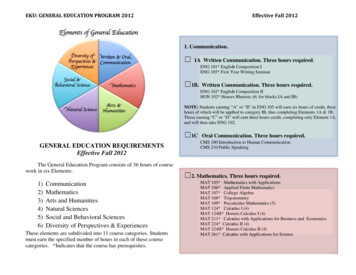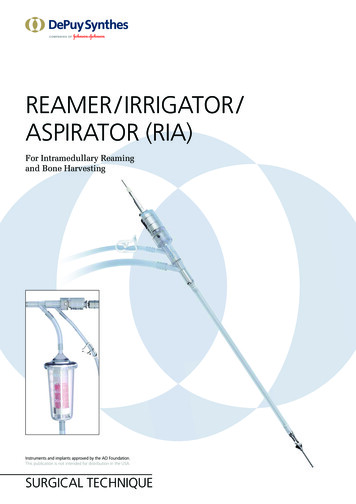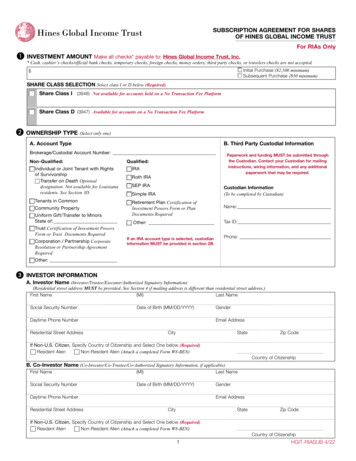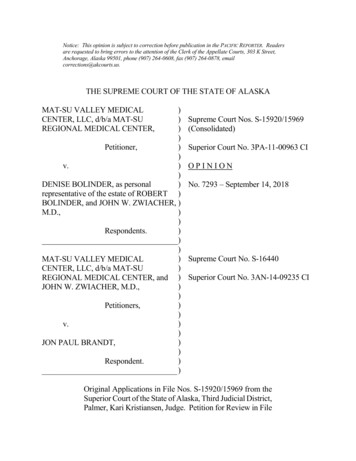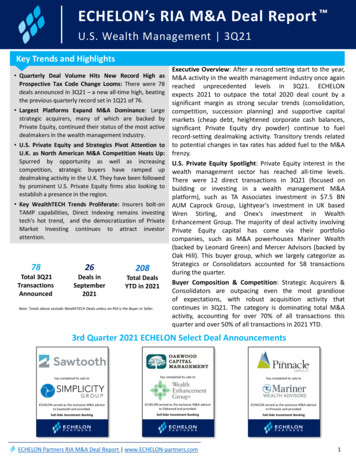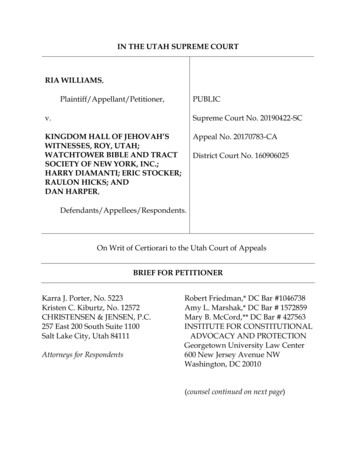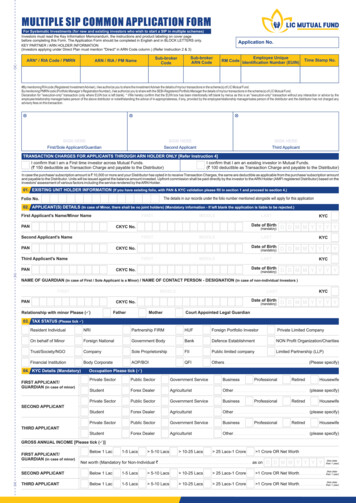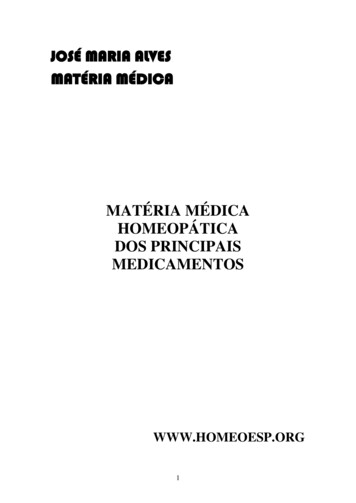
Transcription
JOSÉ MARIA ALVESMATÉRIA MÉDICAMATÉRIA MÉDICAHOMEOPÁTICADOS PRINCIPAISMEDICAMENTOSWWW.HOMEOESP.ORG1
Uma das questões mais problemáticas da Homeopatia, prende-secom o comhecimento da matéria médica.Esta, é extraordinariamente vasta, mais de um milhar demedicamentos, com as suas patogenesias de maior ou menor extensão,características, sintomas, modalidades.Se pretendermos dominar toda a patogenesia de um medicamento,com os seus sinais e sintomas característicos, importantes e secundários,rapidamente abandonaremos tal empresa. Estaremos votados ao insucesso,porquanto iniciado o estudo de um outro, logo a nossa memóriadesperdiçará parte do adquirido. E a este, teriam de seguir-se fatalmentedezenas, se não, centenas.Tendo em conta estas limitações, construímos a nossa matériamédica de forma a que o estudante e o prático possam aproximar-seprogressivamente da sua complexidade. Também não olvidámos osensinamentos de Clarke neste particular, como veremos infra. Começámos por proceder a uma criteriosa selecção demedicamentos – cônscios de que nenhuma será perfeita eisenta de críticas –, restringindo-os aos policrestos, semipolicrestos e pequenos medicamentos, tendo em vista a suaprobabilidade de aparecimento numa repertorização que não serestrinja ao domínio das patologias agudas. A primeira parte da Matéria Médica, em português, tentaidentificar com a síntese possível, o medicamento, permitindouma primeira abordagem, quer no estudo quer em sede dediagnóstico diferencial. Seguem-se em inglês, os estudos de três homeopatas derenome, que qualificamos como o A, B, C da matéria médicahomeopática:- Allen, Henry ClayKeynotes- Boericke, WilliamMatéria Médica- Clarke, John HenryDictionary of Practical Materia Medica2
No nosso texto, em cada medicamento – e desde que aíapareçam –, estão identificados como A, B, e C.O conjunto de todos estes estudos, será em regra suficiente, para queo homeopata possa realizar o objectivo da ciência médica homeopática: adescoberta do simillimum.No estudo da matéria médica, relembremos o ensinamento de Clarke.Este eminente homeopata referia com constância, que o conhecimento dasintomatologia de treze medicamentos seleccionados, habilitaria o prático atratar com sucesso a maioria dos casos que encontrasse.Esses medicamentos devem ser estudados na seguinte ordem:1 – Sulfur;2 – Calcarea Carbonica;3 – Lycopodium;4 – Arsenicum Album;5 – Thuya;6 – Aconitum;7 – Nux Vomica;8 – Pulsatilla;9 – Silicea;10 – Hepar Sulfur;11 – China;12 – Belladonna;13 – Bryonia.O estudante de homeopatia tem de começar por algum lado, tem dese arriscar num imenso oceano de sintomas repartidos por inúmeraspatogenesias.Por outro lado, a matéria médica tem de ser estudada de modo a quenão se assemelhe com uma natureza morta, que da sua leitura resulte oflorescimento de um determinado indivíduo de características típicas. Éfundamental que na mente de cada um, o medicamento “viva” da formamais exacta que se possa conceber.O número de medicamentos constantes desta matéria médica ébastante limitado.No entanto, no domínio do crónico e na sequência de repertorizaçãocorrectamente realizada, dará resolução a praticamente todos os casos quenos surgirem.Naqueles que não resolver, que a falta me seja desculpada.3
Os medicamentos são precedidos por números – veja-se a listagemque se segue –, de forma a que possam ser localizados com rapidez e com autilização dos comandos: EDITAR » LOCALIZAR.Existe um anexo no Repertório Prático de Sintomas GeraisHomeopáticos, online no nosso site – www.homeoesp.org -, que trata dasRelações entre os Medicamentos, Duração de Acção e PrecauçõesEspeciais, anexo este que poderá ser junto a esta Matéria Médica paraconsulta e eficaz prática homeopática.José Maria AlvesOUTUBRO DE 20074
MEDICAMENTOS001 - ABROTANUM – ABROT.002 - ACETICUM ACIDUM – ACET-AC.003 - ACONITUM NAPELLUS – ACON.ACTEA RACEMOSA - VER CIMICIFUGA004 - AESCULUS HIPPOCASTANUM – AESC.005 - AETHUSA CYNAPIUM – AETH.006 - AGARICUS MUSCARIUS – AGAR.007 - ALUMINA – ALUM.008 - AMMONIUM CARBONICUM – AM-C.009 - ANACARDIUM – ANAC.010 - APIS MELLIFICA – APIS011 - ARGENTUM NITRICUM – ARG-N.012 - ARNICA MONTANA – ARN.013 - ARSENICUM ALBUM – ARS.014 - AURUM METALLICUM – AUR.015 - BARYTA CARBONICA – BAR-C.016 - BELLADONNA – BELL.017 - BRYONIA ALBA – BRY.018 - CALCAREA CARBONICA – CALC.019 - CALCAREA FLUORICA – CALC-F.020 - CALCAREA PHOSPHORICA – CALC-P.021 - CANTHARIS – CANTH.022 - CARBO VEGETABILIS – CARB-V.5
023 - CARCINOSINUM – CARC.024 - CAUSTICUM HAHNEMANNI – CAUST.025 - CHAMOMILLA VULGARIS – CHAM.026 - CHINA RUBRA – CHIN.027 - CIMICIFUGA (ACTEA RACEMOSA) –CIMIC.028 - COLOCYNTHIS – COLOC.029 - CONIUM MACULATUM – CON.030 - DULCAMARA – DULC.031 - FERRUM METALLICUM – FERR.032 - GELSEMIUM SEMPERVIRENS – GELS.033 - GRAPHITES – GRAPH.034 - HEPAR SULPHUR – HEP.035 - HYOSCIAMUS NIGER – HYOS.036 - IGNATIA AMARA – IGN.037 - IODUM – IOD.038 - IPECACUANHA – IPEC.039 - KALIUM BICHROMICUM – KALI-BI.040 - KALIUM CARBONICUM – KALI-C.041 - LACHESIS MUTUS – LACH.LUESINUM – VER SYPHILINUM.042 - LYCOPODIUM CLAVATUM – LYC.043 - MAGNESIA CARBONICA – MAG-C.044 - MEDORRHINUM – MED.045 - MERCURIUS SOLUBILIS – MERC.6
046 - MEZEREUM – MEZ.047 - NATRUM CARBONICUM – NAT-C.048 - NATRUM MURIATICUM – NAT-M.049 - NATRUM SULPHURICUM – NAT-S.050 - NITRICUM ACIDUM – NIT-AC.051 - NUX VOMICA – NUX-V.052 - OPIUM – OP.053 - PETROLEUM – PETR.054 - PHOSPHORICUM ACIDUM – PH-AC.055 - PHOSPHORUS – PHOS.056 - PLATINUM METALLICUM – PLAT.057 - PLUMBUM METALLICUM – PLB.058 - PSORINUM – PSOR.059 - PULSATILLA – PULS.060 - RHUS TOXICODENDRON – RHUS-T.061 - SEPIA – SEP.062 - SILICEA – SIL.063 - STAPHYSAGRIA – STAPH.064 - SULPHUR – SULPH.065 - SYPHILINUM – SYPH.066 - THUYA OCCIDENTALIS – THUJ.067 - TUBERCULINUM – TUB.068 - VERATRUM ALBUM – VERAT.069 - ZINCUM METALLICUM – ZINC.7
001 – ABROTANUMHá em Abrotanum uma fadiga muito acentuada, uma grandefraqueza.É um indivíduo que apresenta sinais de depressão e ansiedade comdesalento.Traços caracteriológicos pouco abonatórios: crueldade, violência,teimosia. Mau humor.Não se pode dizer que seja inteligente.Definhamento muito marcante.A criança apresenta traços de envelhecimento, em especial o rostodenso de rugas, franzido. Tem um olhar de desalento, tristonho. Incapaz demanter a cabeça direita ou de ficar em pé.Emagrecimento notável, com realce ao nível das pernas. Tembastante fome, alimenta-se bem, mas mesmo assim emagrece.Tem a sensação do estômago estar imerso num líquido, em água.O abdómen está distendido e na palpação encontram-se pontos duros.Diarreia que alterna com prisão de ventre.Dores nas articulações.Reumatismo que alterna com diarreia.Frieiras.8
Hemorragia umbilical.AGRAVAÇÃO: ao ar frio; durante a noite.MELHORA: com o movimento.AAlternate constipation and diarrhoea; lineteria. Marasmus ofchildren with marked emaciation, especially of legs (Iod., Sanic.,Tub.); the skin is flabby and hangs loose in folds (of neck, Nat. m.,Sanic.). In marasmus head weak, cannot hold it up. (Aeth.).Marasmus of lower extremities only. Ravenous hunger; loosing fleshwhile eating well (Iod., Nat. m., Sanic., Tub.). Painful contractions ofthe limbs from cramps or following colic. Rheumatism; for theexcessive pain before the swelling commences; from suddenlychecked diarrhoea or other secretions; alternates with haemorrhoids,with dysentery. Gout; joints stiff, swollen, with pricking sensation;wrists and ankle-joints painful and inflamed. Very lame and sore allover. Itching chilblains (Agar.). Great weakness and prostration anda kind of hectic fever with children; unable to stand. Child is illnatured, irritable, cross and despondent; violent, inhuman, would liketo do something cruel. Face old, pale, wrinkled (Op.).Relationship: After Hepar in furuncle; after Acon. and Bry. inpleurisy, when pressing sensation remains in affected side impedingrespiration.9
BA very useful remedy in marasmus, especially of lowerextremities only, yet with good appetite. Metastasis. Rheumatismfollowing checked diarrhœa. Ill effects of suppressed conditionsespecially in gouty subjects. Tuberculous peritonitis. Exudativepleurisy and other exudative processes. After operation upon thechest for hydrothorax or empyæmia, a pressing sensation remains.Aggravation of hæmorrhoids when rheumatism improves. Nosebleedand hydrocele in boys.Great weakness after influenza (Kali phos).Mind.--Cross, irritable, anxious, depressed.Face.--Wrinkled, cold, dry, pale. Blue rings around dull-lookingeyes. Comedones, with emaciation. Nosebleed. Angioma of the face.Stomach.--Slimy taste. Appetite good, but emaciation progresses.Food passes undigested. Pain in stomach; worse at night; cutting,gnawing pain. Stomach feels as if swimming in water; feels cold.Gnawing hunger and whining. Indigestion, with vomiting of largequantities of offensive fluid.Abdomen.--Hard lumps in abdomen. Distended. Alternate diarrhœaand constipation. Hæmorrhoids; frequent urging; bloody stools;worse as rheumatic pains abate. Ascarides. Oozing from umbilicus.Sensation as if bowels were sinking down.Respiratory.--Raw feeling. Impeded respiration. Dry coughfollowing diarrhœa. Pain across chest; severe in region of heart.Back.--Neck so weak cannot hold head up. Back lame, weak, andpainful. Pain in lumbar region extending along spermatic cord. Painin sacrum, with hæmorrhoids.Extremities.--Pain in shoulders, arms, wrists, and ankles. Prickingand coldness in fingers and feet. Legs greatly emaciated. Joints stiffand lame. Painful contraction of limbs (Amm mur).10
Skin.--Eruptions come out on face; are suppressed, and the skinbecomes purplish. Skin flabby and loose. Furuncles. Falling out ofhair. Itching chilblains.Modalities.--Worse, cold air, checked secretions. Better, motion.Relationship.--Compare: Scrophularia; Bryonia; Stellaria; Benzoicacid, in gout. Iodine, Natr mur in marasmus.Dose.--Third to thirtieth potency.CClinical. Boils. Chilblains. Epilepsy. Gout. Hæmorrhoids. Hecticfever. Hydrocele. Indigestion. Lienteria. Marasmus. Myelitis,chronic. Nose-bleed. Paralysis. Rheumatism. Umbilicus, oozingfrom. Worms.Characteristics. The most prominent symptom of Abrot. is thewasting it causes, most marked in lower extremities. It has also anintense indigestion and morbid appetite. There are burning, gnawing,constricting pains, and sometimes vomiting of offensive matters. Apeculiar sensation is as if the stomach were hanging or swimming itswater. After a checked diarrhœa, rheumatism may ensue. Anothergreat characteristic of Abrot. is metastasis; metastatic rheumatism.Metastasis of rheumatism from joints to heart; to spine. There is asudden aching pain in back by motion. Symptoms are at nightand in cold air. The face is wrinkled, pale, old-looking; feels cold;blue rings round eyes. It is suited to affections of newborn children,and especially little boys; hydrocele; epistaxis; emaciation. Oozingof blood and moisture from navel of newborn. I have cured with itindigestion with vomiting of large quantities of offensive fluid in amiddle-aged woman.Relations. Compare: Absinth., Cham., Cina, Gnaphal., and otherCompositæ; Nux and Agar. (chilblains); Bry., Bar. c. Follows well:Acon. and Bry. (pleurisy); Hep. (boils).11
SYMPTOMS.1. Mind. Great anxiety and depression. Child cross, depressed,very peevish. Feels she would like to do something cruel; nohumanity. Thinking difficult. Feels as if brain softening. Excited,loquacious, like shouting, good-humoured, happy (secondary, afterceasing the drug).2. Head. Cannot hold the head up. The l. brain seems esp. weak,easily tired by conversation or mental effort. Sensation as ofcreeping chills along the convolutions of the brain, accompanied byprickling sensation. Scalp sore, esp. l. side; itching.3. Eyes. Blue rings around dull-looking eyes.5. Nose. Nose dry. Nose-bleed with boys.6. Face. Face wrinkled, as if old. Comedones, with emaciation.8. Mouth. Slimy taste; acid.10. Appetite. Gnawing hunger, craves bread boiled inmilk. Ravenous appetite, and all the while emaciating. Gastralgiawith loss of appetite.11. Stomach. Sensation as if stomach were hanging or swimmingin water, with coldness. Pains cutting, gnawing, burning; at night.12. Abdomen. Great distension of abdomen. Weak, sinkingfeeling in bowels. Hard lumps in different parts of abdomen.13. Stool and Anus. Food passes undigested. Rheumatism aftersuddenlycheckeddiarrhœa. Alternatediarrhœaandconstipation. Protruding piles, with burning, from touch or whenpressing. Piles appeared, and became worse as rheumatic painsabated, with frequent inclination to stool, hardly anything but bloodbeing passed. Destroys worms, esp. ascarides.15. Male Sexual Organs. Hydrocele of children.16. Female Sexual Organs. Darting pain in left ovary. Twitchingin both ovarian regions, seems to extend to back. Blood andmoisture oozing from navel of newborn.12
17. Respiratory Organs. Cold air causes a raw feeling inrespiratory tract. In pleurisy when a pressing sensation remains inaffected side, impeding free breathing (after Acon. and Bry.).19. Heart and Pulse. Pain across chest sharp and severe in regionof heart; rheumatism. Metastasis of rheumatism to heart. Pulseweak and small.20. Back. Pains in sacrum.21. Limbs. Inability to move. Marasmus of lower extremitiesonly. Soreness and lameness; worse mornings. Chilblains itch;frost-bitten limbs. Gout in wrists and ankles. Inflammatoryrheumatism before swelling begins.24. Generalities. Weak, sickly feeling when excited,trembling. Lame and sore all over. Weak and prostrated afterinfluenza. Inability to move. Numbness.25. Skin. Flabby; hangs loose; marasmus. Furunculus; after Hep.s.26. Sleep. Restless; frightful dreams.27. Fever. High fever (rheumatism). Hectic fever, with chilliness,very weakening; (marasmus).13
002 – ACETICUM ACIDUMEstá num permanente estado de angústia. As suas queixas nãoterminam.Tudo é um verdadeiro problema; nesta perspectiva está sempre àespera que lhe aconteça o pior.A sua memória não é propriamente famosa. O seu pensamento écaótico, confuso. Por vezes não reconhece as pessoas que lhe são maischegadas, e mesmo os próprios filhos. Esquecimento de factos recentes.Custa-lhe lembrar-se de palavras correntes quando fala ou escreve.Ansiedade com sinais evidentes de nervosismo.Irritabilidade. Irrita-se com facilidade.O rosto é pálido, tão pálido que parece de cera.As pupilas estão dilatadas.Dor de cabeça com ruborização da parte esquerda do rosto.Não consegue saciar a sede, apesar de beber muito, com exclusão daspatologias febris.Gengivas que sangram.Manchas brancas na língua.Tem dores de estômago bastante fortes, com ardência, e não suportaingerir comida fria ou salgada. Aversão aos alimentos salgados e aosalimentos frios.Abdómen distendido.14
Diarreia de fezes do tipo aquoso, por vezes com sangue. Doresabdominais.Urina abundantemente.Dores na lombar.Edema de pés e pernas.Febre com significativa variabilidade, sem sede, contrariamente atodos os outros padecimentos em que a sede é praticamente inextinguível.AGRAVAÇÃO: deitado de costas.MELHORA: deitado de bruços.AAdapted to pale lean persons with lax, flabby muscles; facepale, waxy (Fer.). Haemorrhage; from every mucous outlet, nose,throat, lungs, stomach, bowels, uterus (Fer., Mill.); metrorrhagia;vicarious; traumatic epistaxis (Arn.). Marasmus and other wastingdiseases of children (Abrot., Iod., Sanic., Tub.). Great prostration;after injuries (Sulph. ac.); after surgical shock; after anaesthetics.Thirst; intense, burning, insatiable even for large quantities indropsy, diabetes, chronic diarrhoea; but no thirst in fever. Sourbelching and vomiting of pregnancy, burning water-brash andprofuse salivation, day and night (Lac. ac., salivation at night, Mer.s.). Diarrhoea; copious, exhausting, great thirst; in dropsy, typhus,phthisis; with night sweats. True croup, hissing respiration, coughwith inhalation (Spong.); last stages. Inhalation of vapor of cidervinegar has been successfully used in croup and malignantdiphtheria. Cannot sleep lying on the back (sleeps better on back,Ars.); sensation of sinking in abdomen causing dyspnoea; restsbetter lying on belly (Am. c.). Hectic fever, skin dry and hot; red spoton left cheek and drenching night sweats.15
Relationship. It antidotes anaesthetic vapors (Amyl.); fumes ofcharcoal and gas; Opium and Stramonium. Cider vinegar antidotesCarbolic acid. Follows well; after Cinchona, in haemorrhage; afterDigitalis, in dropsy. It aggravates; the symptoms of Arn., Bell.,Lach., Mer., especially the headache from BelladonnaBThis drug produces a condition of profound anæmia, withsome dropsical symptoms, great debility, frequent fainting, dyspnœa,weak heart, vomiting, profuse urination and sweat. Hæmorrhagefrom any part. Especially indicated in pale, lean persons, with lax,flabby muscles. Wasting and debility. Acetic acid has the power toliquefy albuminous and fibrinous deposits. Epithelial cancer,internally and locally (W Owens). Sycosis with nodules andformations in the joints. Hard chancre. The 1x solution will softenand cause formation of pus.Mind.--Irritable, worried about business affairs.Head.--Nervous headache, from abuse of narcotics. Blood rushes tohead with delirium. Temporal vessels distended. Pain across root oftongue.Face.--Pale, waxen, emaciated. Eyes sunken, surrounded by darkrings. Bright red. Sweaty. Epithelioma of lip. Cheeks hot andflushed. Aching in left jaw-point.Stomach.--Salivation. Fermentation in stomach. Intense burningthirst. Cold drinks distress. Vomits after every kind of food.Epigastric tenderness. Burning pain as of an ulcer. Cancer ofstomach. Sour belching and vomiting. Burning waterbrash andprofuse salivation. Hyperchlorhydria and gastralgia. Violent burningpain in stomach and chest, followed by coldness of skin and coldsweat on forehead. Stomach feels as if she had taken a lot of vinegar.16
Abdomen.--Feels as if abdomen was sinking in. Frequent waterystools, worse in morning. Tympanitic. Ascites. Hæmorrhage frombowels.Urine.--Large quantities of pale urine. Diabetes, with great thirst anddebility (Phos ac).Female.--Excessive catamenia. Hæmorrhages after labor. Nausea ofpregnancy. Breasts painfully enlarged, distended with milk. Milkimpoverished, bluish, transparent, sour. Anæmia of nursing mothers.Respiratory.--Hoarse, hissing respiration; difficult breathing; coughwhen inhaling. Membranous croup. Irritation of trachea andbronchial tubes. False membrane in throat. Profuse bronchorrhœa.Putrid sore throat (gargle).Back.--Pain in back, relieved only by lying on abdomen.Extremities.--Emaciation. Œdema of feet and legs.Skin.--Pale, waxen, œdematous. Burning, dry, hot skin, or bathed inprofuse sweat. Diminished sensibility of the surface of body. Usefulafter stings, bites, etc. Varicose swellings. Scurvy; anasarca.Bruises; sprains.Fever.--Hectic, with drenching night-sweats. Red spot on left cheek.No thirst in fever. Ebullitions. Sweat profuse, cold.Relationship.--Acetic acid is antidotal to all anæsthetic vapors.Counteracts sausage poisoning.Compare: Ammon acet (Profuse saccharine urine, patient is bathed insweat). Benzoin oderiferum--Spice-wood (night sweats). Ars; China;Digitalis; Liatris (General anasarca in heart and kidney disease,dropsy, and chronic diarrhœa).Dose.--Third to thirtieth potency. Not to be repeated too often,except in croup.17
CClinical. Anæmia. Anæsthetics, antidote to. Ascarides. Burns.Corns. Croup. Debility. Diabetes. Diphtheria. Dropsies. Fevers.Hydrophobia. Nævi. Narcotics, antidote to. Phthisis. Sausagepoisoning, antidote to. Scalds. Stings. Stomach, cancer of. Varicosis.Warts.Characteristics. The leading features of acetic acid are excessivewasting and debility; anæmia with waxy pallor of face; intense thirst;burning in throat; nausea, retching, and sour rising as met with incases of cancer and debility. There are gnawing, ulcerative pains instomach; pain and burning in abdomen. Profuse, exhaustingdiarrhœa. It has been used in diabetes. It corresponds to putrid andhectic fevers with night sweats; hæmorrhages, varicose swellings,and dropsies. As a type of vinegar effects may be mentioned thefollowing: A plump and blooming young woman took a small glassdaily to reduce size. Soon lost flesh and colour. In a month cough setin with white concocted phlegm, fever, dyspnœa, night sweats,anorexia, dropsy, diarrhœa, death. Lungs after death were foundstuffed with non-suppurating tubercles. A young German, afterworking twelve months in a vinegar factory, was obliged to leavefrom indigestion, dyspnœa, and ready fatigue. It is suited to childrenand old people; to lax, pale, lean persons. (Equal parts of vinegar andhot water make a refreshing sponge-down for many conditions offever, with or without perspiration.)Relations. Compare: Apis, Ars. (but Acet. ac. has morepreponderant gastric symptoms than either); Carbol. ac., Lac. defl.,Lact. ac., Uran. nit. Large doses of Acet. ac. are best antidoted byMagnesia or Calcarea either as fluid magnesia or as lime-water.Antidotes to potencies are: For depressing, agonising feeling, Tabac.,Acon.; for gastric, pulmonary and febrile symptoms, Nat. m., andafterwards Sep. It antidotes: Anæsthetics, Acon., Asar., Coffea,Euphorb., Ignat., Opium, Plumb. (colic), Sep., Stram., Tabac. Itcounteracts sausage-poisoning. It aggravates the effects of Bell.,Merc., Arn., Lach. Disagrees when given after Borax, Caust., Nuxv., Ran. b., Sars.: Scilla, Colch., and Sang. have more effect in curingsome diseases when prepared with Acet. ac. than with Alcohol.18
SYMPTOMS.1. Mind. Very dull and low-spirited; irritable. Alternate stupor anddelirium. Confusion of ideas. Grieves much; sighs often. Horribleattacks of anxiety with difficult breathing. Vertigo with feeblenessand fainting.2. Head. Heaviness and dull pains in forehead andvertex. Headache from abuse of tobacco, opium, coffee, or alcohol.5. Nose. Liable to frequent catarrhal attacks. Nose-bleed, esp. froma fall or a blow.6. Face. Expression wild, pupils dilated. Face pale, waxen,emaciated. Left cheek (esp.) very red during fever. Bright red flushon both cheeks. Sweat on forehead in spots.8. Mouth. Teeth feel dull, breath foul. Scorbutic ulcers;toothache. Taste sour. Epithelium of mouth quite white. Tonguepale and flabby.9. Throat. Children thirsty, but swallow with difficulty even ateaspoonful of water. White false membranes in throat.11. Stomach. Insatiable burning thirst. Shrieks for water atnight. Intense thirst; nausea, and frequent vomiting. Disgust forsalted things and cold victuals. Cold drinks lie heavy. Vegetables,except potatoes, disagree, also bread and butter still more. Contentsof stomach feel as if in a ferment; violent burning pain in stomachand in chest, followed by coldness of the skin and cold sweat onforehead. Indurations in stomach. Scirrhus of pylorus.12.Abdomen. Distensionoftheabdomen;colickypains. Ascites. Abdomen feels as if sunken in when lying on hisback.13. Stool and Anus. Diarrhœa, with great thirst, drinking largequantities with apparent impunity. Diarrhœa, with swelling of legsand feet (phthisical subjects). Diarrhœa, with colic pains andtenderness of the abdomen. Hæmorrhage from bowels. Chronicconstipation. Ascarides. Chronic diarrhœa of children with greatemaciation. Constipation, with great thirst and excess of pale urine.19
14. Urinary Organs. Urine increased in quantity; pale; phosphatic;diabetes, with intense, burning, unending and unquenchable thirstand great debility.15. Male Sexual Organs. Weakening emissions; semen passes atstool. Prepuce thickened, fissured, can't be retracted and itchesfearfully. Sexual passion, but feeble erection.16. Female Sexual Organs. Metrorrhagia; after parturition, withgreat thirst.17. Respiratory Organs. Hoarse, with laryngeal irritation. Liningmembrane of larynx and trachea covered with a fibrinous exudationas in true croup. Hissing respiration, with rattling in thethroat. Croup-like cough; a hollow sound with eachinhalation. Hæmoptysis.20. Back. Myelitis, with profuse urine; the pain in the back relievedonly by lying on the abdomen.21. Limbs. Œdematous swelling of the feet and legs.24. Generalities. Convulsions. Jumps out of bed like a madman,and crawls on the ground, howling with pain. Greatemaciation. Skin pale and waxen. General anasarca and dropsicalaffections. Burning in inner and outer parts.25. Skin. Sugillations. Tetter-like eruptions. Nævi; warts; corns.26. Sleep. Sleepless.27. Fever. Skin cold. Slow fever with night sweats. Profuseperspiration. Hectic. Putrid and typhous fevers.20
003 – ACONITUM NAPELLUSAconitum é um medicamento indicado especialmente para casosagudos de aparecimento recente.Patologias que surgem após exposição ao ar frio e seco, aos ventosdo Norte ou de Oeste ou à suspensão da transpiração por violentos golpesde vento frio.O doente de Aconitum é ansioso, inquieto, agitado e tem medo damorte. O medo está sempre presente neste paciente; irracional e envolto poruma angústia exacerbada.Há nele uma excitabilidade nervosa fora do comum, ficandosobressaltado por qualquer acontecimento mesmo que de poucaimportância. A agitação ansiosa com medo da morte acompanhapraticamente todos os sintomas.A agitação é física e mental. O seu rosto é a expressão do medo quenão tem fundamento plausível. A angústia é terrível, com intenso medo damorte; chega a predizer o dia e em certos casos a hora em que vai morrer.Medo da morte durante a gravidez.Crises de angústia por volta da meia noite.A vida transforma-se em algo insuportável por via dos seus medos ecrê que a sua doença lhe será fatal. Qualquer padecimento por mais ligeiroque seja, é acompanhado por angústia e medo. Tem medo de sair de casa,medo da multidão, de atravessar a rua, de qualquer coisa que está poracontecer.Agitado e ansioso, faz tudo apressadamente, mudandoconstantemente de posição.21
Não suporta a música que o entristece.Padece de insónia com uma inquietude que o obriga a mover-seconstantemente no leito. Os sonhos provocam-lhe sobressaltos.Quando se levanta, depois de estar deitado, o seu rosto queapresentava uma cor avermelhada, fica pálido. Pode acontecer que sejaacometido de vertigens e caia, ficando inconsciente; fica então com medode se levantar de novo.Quando tem dores não quer que ninguém se aproxime.As dores são agudas e intoleráveis, geralmente provocadas por golpede ar frio. Mais intensas durante a noite, por vezes com um marcadoentorpecimento. Deixam-no num estado desesperado e são acompanhadasde ansiedade, agitação física e mental, com medo da morte.Nevralgias recentes por exposição ao frio seco, a uma corrente de ar.Nevralgia do trigémeo recente ou crónica, com crises induzidas pelo frioseco ou por bebidas geladas. Todas as outras nevralgias.Febre que aparece de modo brutal em tempo frio. Quando tem febre,o paciente de Aconitum tem a pele seca, quente, ardente. A agitação éenorme, mexe-se sem cessar na cama, movimentos estes que agravam oscalafrios, queixa-se, diz que está perdido, que vai morrer. A sua angústiaagrava no fim da tarde e no momento de dormir. O rosto avermelhado ficabranco quando se levanta. Sede insaciável por grandes quantidades de águafria.Sente a cabeça quente, pesada. Tem vertigens quando se levanta,depois de estar deitado. As suas dores de cabeça frontais, supra-orbitárias,aumentam de intensidade à noite.Por vezes, uma bochecha está avermelhada, enquanto que a outraestá pálida.Cefaleia frontal aguda, por vezes por insolação ou exposição a umcalor intenso.Nevralgia facial por frio.Otite aguda, após golpe de ar frio. O ouvido torna-se sensível e nãosuporta ruídos.A língua está inchada, coberta de um saburro branco ouesbranquiçado, com formigamentos na sua ponta, que também surgem noslábios.Tudo o que come tem gosto amargo, à excepção da água que desejainsaciavelmente.Dores abdominais após golpe de frio seco.22
Gastralgia aguda que surge após absorção de água gelada.Diarreia esverdeada. As fezes parecem espinafres cortados.Rinite aguda antes do corrimento nasal.Tosse crupal repentina, seca, sufocante, que surge antes da meianoite, após exposição a um vento frio e seco. Por vezes, dores intercostais,que são agravadas pela respiração e quando o paciente se deita sobre o ladodoloroso.Rouquidão por força da exposição ao frio seco.Hemoptise de sangue vivo.Todos os sinais cardiovasculares são acompanhados de ansiedade eagitação, agravando pelo frio, o vento frio, o gelo, e à meia noite.Palpitações bruscas, com dores na região do coração e ansiedade com medoda morte. Necessidade do doente ficar deitado com a cabeça elevada.Hipertensão. Taquicardia induzida pela angústia ou pelo frio.O pulso é cheio, tenso e rápido, apresentando em alguns casosalguma intermitência.Fica ansioso antes de urinar.As regras são abundantes e prolongadas. Estas findam subitamentepor efeito de um susto, medo ou depois da paciente ter apanhado frio seco.Amenorreia das jovens.AGRAVAÇÃO: ao fim da tarde e à noite as dores são insuportáveis;à noite; por volta da meia noite; levantando-se da cama; apósexposição ao vento frio e seco; estando deitado do lado doloroso; emum quarto quente; por medo súbito.MELHORA: ao ar livre; repousando; depois de ter transpirado – noscasos agudos –.23
AIt is generally indicated in acute or recent cases occurring inyoung persons, especially girls, of a full, plethoric habit who lead asedentary life; persons easily affected by atmospheric changes; darkhair and eyes, rigid muscular fibre. Complaints caused by exposureto dry cold air, dry north or west winds, or exposure to draughts ofcold air while in a perspiration; bad effects of checked perspiration.Great fear and anxiety of mind, with great nervous excitability;afraid to go out, to go into a crowd where there is any excitement ormany people; to cross the street. The countenance is expressive offear; the life is rendered miserable by fear; is sure his disease willprove fatal; predicts the day he will die; fear of death duringpregnancy.
4 Os medicamentos são precedidos por números - veja-se a listagem que se segue -, de forma a que possam ser localizados com rapidez e com a utilização dos comandos: EDITAR » LOCALIZAR. Existe um anexo no Repertório Prático de Sintomas Gerais Homeopáticos, online no nosso site - www.homeoesp.org -, que trata das Relações entre os Medicamentos, Duração de Acção e Precauções
